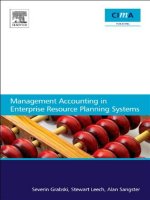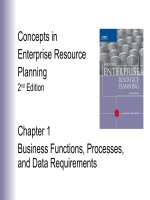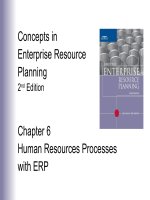Lecture concepts in enterprise resource planning (2nd edition) chapter 6 human resources processes with ERP
Bạn đang xem bản rút gọn của tài liệu. Xem và tải ngay bản đầy đủ của tài liệu tại đây (390.12 KB, 33 trang )
Concepts in
Enterprise Resource
Planning
2nd Edition
Chapter 6
Human Resources Processes
with ERP
Chapter Objectives
• Explain why the Human Resources function is
critical to the success of a company
• Describe the key processes managed by a
Human Resources Department
• Describe how an integrated information system
can support effective Human Resources
Processes
Concepts in Enterprise Resource Planning, Second Edition
2
Introduction
• A company’s employees are its most important
resources
• The Human Resources Department is responsible for:
• Attracting
• Hiring
• Rewarding
• Terminating
employees
• The importance of HR processes to all functional areas
has led to the use of the term Human Capital
Management (HCM) to describe them
Concepts in Enterprise Resource Planning, Second Edition
3
HR Department Responsibilities
• Attracting, selecting, and hiring new employees using
information from resumes, references, and the interview
process
• Communicating information regarding new positions and
hires throughout the organization and beyond
• Ensuring that employees have the proper education,
training and certification to successfully complete their
duties
• Handling issues related to employee conduct
• Making sure employees understand the responsibilities
of their jobs
Concepts in Enterprise Resource Planning, Second Edition
4
HR Department Responsibilities
• Using an effective process to review employee
performance and determine salary increases and
bonuses
• Managing the salary and benefits provided to each
employee and confirming that the proper benefits are
disbursed to new and current employees
• Communicating changes in salaries, benefits, or policies
to employees
• Supporting management plans for changes in the
organization (expansion, retirements and so on) so that
competent employees are available to support business
processes
Concepts in Enterprise Resource Planning, Second Edition
5
Problems with Fitter Snacker’s HR Processes
• Paper job vacancy form allows for inconsistent job
details and descriptions:
• Qualifications incomplete
• Requires skills not spelled
• Paper form can be lost, delaying hiring process
• Functional department left shorthanded
• Good candidates lost due to drawn-out hiring process
• Keeping track of resumes submitted from different
sources is problematic
• Being able to retrieve resumes on file that fit a job
description is difficult, time-consuming and fraught
with error
Concepts in Enterprise Resource Planning, Second Edition
6
Problems with Fitter Snacker’s HR Processes
• Interviewing Process Problems:
• Without group appointment software, HR has difficulty
scheduling interviews when all interested parties are
available
• Similarly, collecting feedback on the job candidates is
difficult
• Managing travel arrangements and reimbursing
candidates for travel expenses is also a problem
• Delays may result in losing a top candidate
• Gathering new employee information and enrolling
employee in correct benefits plan is difficult
• May take months to get employees proper
compensation and benefits
Concepts in Enterprise Resource Planning, Second Edition
7
HR Duties after Hiring
• Performance Evaluations
• Important to maintain sufficient documentation on
underperforming employees in case termination is
warranted
• Without proper documentation, lawsuits may follow
• Difficulties in managing performance evaluation data
makes it difficult to identify employee problems and
take corrective action (counseling, transfer) before
problem leads to termination
• Maintaining proper control of sensitive data is also
difficult with a paper system
Concepts in Enterprise Resource Planning, Second Edition
8
HR Duties after Hiring
• Employee satisfaction is strongly related to job turnover
• Well compensated employees with satisfying jobs are
less likely to leave the company
• Human Resources can help maintain a satisfying
work environment through:
• Training programs through supervisors and
managers
• Conducting employee satisfactions surveys
• Conducting employee exit surveys
• Human resources should ensure compensation levels
are competitive and applied fairly to all employees
Concepts in Enterprise Resource Planning, Second Edition
9
Another Look—Boeing Discrimination
• In 1996, the Labor Department’s Office of Federal
Contract Compliance Programs (OFCCP) ran a routine
investigation of Boeing’s Philadelphia plant
• Because Boeing works on government contracts, the
Federal Government has the right to audit Boeing’s
compliance with anti-discrimination laws
• By comparing median pay of male and female
employees and their median job experience, the
OFCCP found a “prima facie” (at first view) case of
discrimination
Concepts in Enterprise Resource Planning, Second Edition
10
Another Look—Boeing Discrimination
• Boeing conducted its own internal analysis, Diversity
Salary Analysis project, which concluded “gender
differences in starting salaries generally continue and
often increase as a result of salary planning
decisions”
• The DSA project showed a gap of $3,741.04 for
entry level managers
• Boeing attempted to keep the DSA project study
confidential, but was ordered by Judge George Pinkie
to release it
• On May 17, 2004, Boeing settled a class-action
lawsuit for $72.5 million
Concepts in Enterprise Resource Planning, Second Edition
11
Another Look—Major League Baseball
• The Society for American Baseball Research uses a
statistical technique called sabremetrics to analyze
player performance in a number of situations, e.g.:
• Probability of getting a hit with players on base and
type of hit likely
• Boston Red Sox are using the measures to analyze its
roster and determine the type of player it should recruit
• Department store chain Target is using this analytical
approach to screen job applicants
• Dow Chemical used data on its PeopleSoft ERP system
to find that its most successful MBA candidates came
from Michigan State, Brigham Young and Purdue, not
Ivy League schools
Concepts in Enterprise Resource Planning, Second Edition
12
Human Resources with ERP
• Managing a company’s human capital is information
intensive
• Electronic storage of data greatly simplifies the
retrieval of important data
• The SAP R/3 HR module provides tools to:
• Manage an organization’s structure, job roles and
responsibilities, and definitions
• Personal employee information
• Time management
• Payroll
• Travel management
• Employee training
Concepts in Enterprise Resource Planning, Second Edition
13
Organizational Management
• Most companies have an organizational chart or plan to
help define an individuals responsibilities in the
organization
• With ERP, the organizational chart provides a structure
to support additional tasks
• SAP R/3 provides an Organizational and Staffing Plan
tool to define a company’s management structure and
define positions within the organizational structure
• The plan can also define the individuals that hold
each position
Concepts in Enterprise Resource Planning, Second Edition
14
Organizational Units
Positions
Person holding position
Figure 6.1 Organization and Staffing Plan in SAP R/3
Concepts in Enterprise Resource Planning, Second Edition
15
Task, Job, Position and Person
• SAP distinguishes between Task, Job, Position, and
Person
• An employee is a Person who performs Tasks
• Tasks can be assigned to:
• Jobs, which are generic descriptions of an
employee’s work responsibilities
• Positions, which are the specific organizational
assignments a person holds
• If Tasks, Jobs and Positions are well-defined and
current, then recruiting is simplified and compensation
levels can be set more consistently and fairly
Concepts in Enterprise Resource Planning, Second Edition
16
Concepts in Enterprise Resource Planning, Second Edition
17
Job
Task
assigned
to Job
Figure 6.3 Assignment of a Task to a Job in SAP R/3
Concepts in Enterprise Resource Planning, Second Edition
18
Manager’s Desktop
• The SAP HR Module provides the Manager’s Desktop, a
tool that provides access to all Human Resource data
and transactions in one location
• Human Resource data is very sensitive, so controlling
access is critical
• With an integrated information system, controlling
access is simplified as a range of authorization tools are
available
• See User Authorizations in Chapter 5, pp. 128-129
Concepts in Enterprise Resource Planning, Second Edition
19
Employees in manager’s organization
Functions in task area
Figure 6.4 Manager’s Desktop provides single-point access to HR functions
Concepts in Enterprise Resource Planning, Second Edition
20
Advanced SAP R/3 HR Features
• Time Management
• Cross Application Time Sheets (CATS) record
employee working times and provide data to:
• Controlling (CO), for cost management
• Payroll, for calculating payroll data, which is
transferred to FI for payment
• Production Planning (PP), to manage labor
required for production
Concepts in Enterprise Resource Planning, Second Edition
21
Advanced SAP R/3 HR Features
• Payroll Management
• Paying employees the correct amount at the correct
time is critical for employee satisfaction
• Payroll calculations are complicated, involving:
• Remuneration Elements:
• Base pay, bonuses, gratuities, overtime and
sick pay, vacation allowances
• Statutory and Voluntary Deductions
• Taxes: Federal, State, Local
• Medicare and Social Security
• Benefit contributions
• Company loans
Concepts in Enterprise Resource Planning, Second Edition
22
Advanced SAP R/3 HR Features
• Travel Management
• Companies can spend a significant amount of money
on employee travel
• Managing travel planning and expenses requires a
number of tasks
• Travel authorizations
• Travel reservations
• Must meet trip requirements while controlling
costs
• Recording expenses and providing reimbursement
Concepts in Enterprise Resource Planning, Second Edition
23
Another Look—FXIS
• Fuji Xerox Information Systems (FXIS) wanted to be able
to close its books two days after the end of the month
• To do this, FXIS chose to implement SAP R/3
• FXIS chose to implement the SD, MM, FI, CO, PS
and HR modules
• Integration of HR data was emphasized
• To meet the two-day closing, FXIS needed expense
information from its sales force, plus time charge data
from software developers and system administrators
• FXIS developed its Web-based DI system to collect
this data
• DI was so successful, FXIS formed an ERP solution
business
Concepts in Enterprise Resource Planning, Second Edition
24
Advanced SAP R/3 HR Features
• Training and Development
• The Personnel Development component of the SAP
R/3 Human Resources module supports planning and
implementation of employee development and
training activities
• Employee development is driven by Requirements
and Qualifications
• Requirements: Skills or abilities associated with a
position
• Qualifications: Skills or abilities associated with a
specific employee
• Two perspectives on the same concept
Concepts in Enterprise Resource Planning, Second Edition
25









